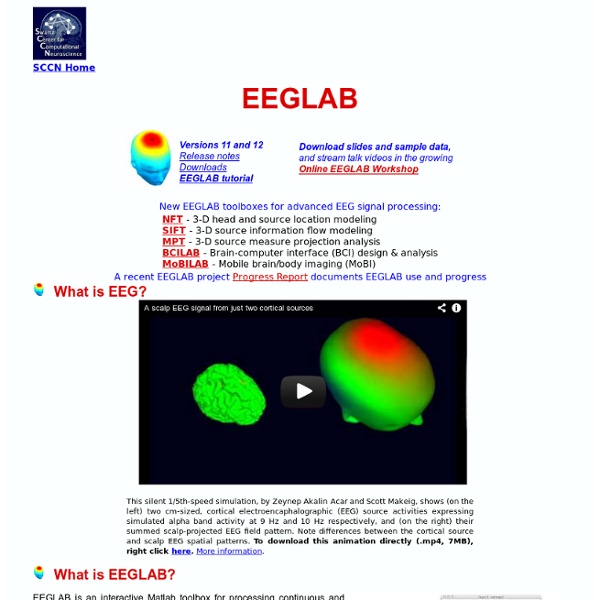EEGLAB
EEGLAB provides an interactive graphic user interface (GUI) allowing users to flexibly and interactively process their high-density EEG and other dynamic brain data using independent component analysis (ICA) and/or time/frequency analysis (TFA), as well as standard averaging methods. EEGLAB also incorporates extensive tutorial and help windows, plus a command history function that eases users' transition from GUI-based data exploration to building and running batch or custom data analysis scripts. EEGLAB offers a wealth of methods for visualizing and modeling event-related brain dynamics, both at the level of individual EEGLAB 'datasets' and/or across a collection of datasets brought together in an EEGLAB 'studyset.' For experienced Matlab users, EEGLAB offers a structured programming environment for storing, accessing, measuring, manipulating and visualizing event-related EEG data. EEGLAB Statistics EEGLAB Workshops EEGLAB Development Feedback?
Arduino-Brain-Library
OpenEEG project
About the project Many people are interested in what is called neurofeedback or EEG biofeedback training, a generic mental training method which makes the trainee consciously aware of the general activity in the brain. This method shows great potential for improving many mental capabilities and exploring consciousness. Other people want to do experiments with brain-computer interfaces or just want to have a look at their brain at work. Unfortunately, commercial EEG devices are generally too expensive to become a hobbyist tool or toy. The OpenEEG project is about making plans and software for do-it-yourself EEG devices available for free (as in GPL). Right now, this site is mostly about the hardware; schematics, part lists, building instructions etc. Some regulatory business Commercial and clinical EEG devices must live up to certain standards. In other words, if you decide to build and use one -- the responsibility is yours.
BCI2000
What is BCI2000? BCI2000 is a general-purpose system for brain-computer interface (BCI) research. It can also be used for data acquisition, stimulus presentation, and brain monitoring applications. Mission The mission of the BCI2000 project is to facilitate research and applications in the areas described above. Vision Our vision is that BCI2000 will become a widely used software tool for diverse areas of real-time biosignal processing. Availability The BCI2000 system is available for free for non-profit research and educational purposes. BCI2000 development has been sponsored by a NIH (NIBIB/NINDS) Bioengineering Research Partnership grant to Jonathan Wolpaw and a NIH (NIBIB) R01 grant to Gerwin Schalk.
Puzzlebox
np_mindset by Machulis
Mind your OSCs
Processing EPOC via OSC by Madara
Related articles: AffectCircles How would you like to create interactive art that responds to your thoughts, moods, and facial expressions? Thanks to Mind Your OSCs and oscP5, interpreting the Emotiv EPOC‘s data within a Processing sketch (and by extension, Arduino) could not be easier, even with the consumer (i.e. most affordable) version of the EPOC. This effectively allows anyone to develop a great variety of (open-source, if desired) EPOC applications including physical computing, even if they have only the consumer headset [1]. Here is how it works. To begin, you need an Emotiv EPOC and the Mind Your OSCs application which you can download for free from the Emotiv store. In the right-hand side of the Mind Your OSCs window, you can see the IP address and port number for data going out of Mind Your OSCs (connection info for data coming into Mind Your OSCs from the EPOC device or an emulator, etc., is displayed on the left-hand side of the window):
Processing-Brain-Grapher
Related:
Related:



